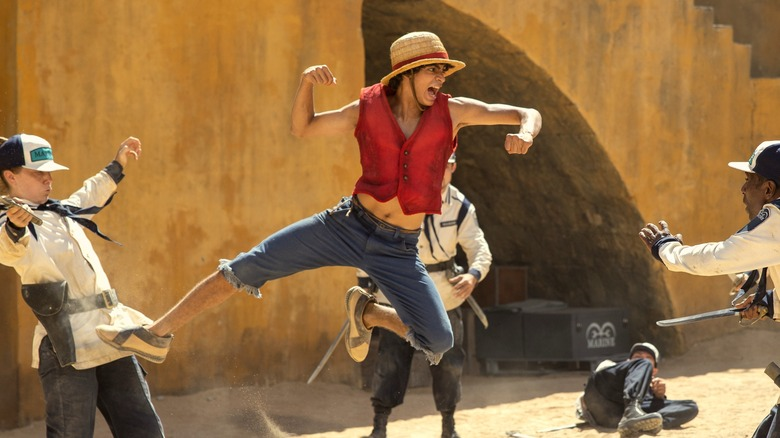Netflix's One Piece Just Showed Marvel How To Shoot The Most Underrated Superpower
Netflix's live-action adaptation of "One Piece," Eiichiro Oda's decades-long manga franchise, understands the source material is fantastical. Instead of grounding the story's whimsy in reality, the studio leaned hard into the series' strangeness, a brilliant move that earned the admiration of more people than it lost. Characters like Monkey D. Luffy (Iñaki Godoy) and Sanji (Taz Skylar) call out their finishing moves with the same reckless abandon as they do in the anime, the World Government still communicates with Transponder Snails, and the superhuman Devil Fruit abilities, like Buggy the Star Clown's nightmare-inducing telekinetic flesh tornado, are just as wild as Oda originally imagined them.
And it's there that Netflix arguably one-upped Marvel Studios because the MCU is a bit notorious for underutilizing any superpower that can't be molded into the approximate shape of a fist. Nowhere is this clearer than in the dichotomy between how Netflix visualizes Luffy's powers and how Marvel — and 20th Century Studios, if we go back far enough — visualizes Mister Fantastic's (Ioan Gruffudd, Miles Teller, and John Krasinski) stretchiness. Functionally, the captain of the Straw Hat Pirates and the leader of the Fantastic Four share the same abilities, and yet, only one of them gets to explore what that means in their respective live-action media properties. Here's a hint ... it's not Reed Richards.
Live-action Mister Fantastic's elasticity is a secondary trait, Luffy's isn't
It would be unfair to say that 20th Century Studios didn't understand that Mister Fantastic (Ioan Gruffudd) could be used for more than an elastic version of Inspector Gadget's Extendo Arm. In the studio's first "Fantastic Four" film, the hero stretches his cheek for a closer shave, flattens his body into a net to capture Doctor Doom (Julian McMahon), and morphs into a funnel to redirect the flow of a gushing fire hydrant. There isn't much, though, which is especially depressing in the context of a film that almost solely focuses on the Fantastic Four hanging out in a lab to test their abilities.
What's more, neither of 20th Century Studios' further "Fantastic Four" projects delve deeper into what it truly means to be made of rubber. As for Marvel Studios' brief take on the Illuminati member, well ... its variant of Mister Fantastic (John Krasinski) doesn't do much more than become a screaming playdough extruder. That's not exactly the sort of thing audiences would find compelling.
But Netflix's take on Monkey D. Luffy displays a full range of defensive and offensive creativity. Yes, he does the Extendo Arm bit — with his arm, leg, and even neck — but audiences are also treated to the side effects of hyperelasticity. Luffy rebuffs a literal cannonball with his stomach, like some human airbag. And swords and knives don't really do anything to him either because he just bends with the stab. Unlike the Marvel films, Netflix lets Luffy live in a space where his powers are integral to how he interacts with the world around him.
Netflix's One Piece is designed to show superpowers, the MCU isn't
Despite the ever-growing enormity of the Marvel Cinematic Universe, modern superhero films are primarily origin stories. They follow characters who are people first and heroes second. The formula is a familiar one — and not necessarily bad — but it leads to a few frustratingly consistent problems, like how the titular superhero almost always spends the bulk of the film struggling to link to their new abilities. From a narrative standpoint, that makes perfect sense, but from an audience standpoint, it means precious little screen time will be devoted to the superpowers that make the hero unique. The formula also cuts down on the CGI budget, which is already paper thin, but that's a topic for a different day. All this is to say that Mister Fantastic never stood a chance to flex his rubber muscles.
Netflix's "One Piece" does not adhere to the superhero origin story formula. Yes, Luffy is functionally a superhero, and yes, Season 1 is functionally an origin story, but the narrative throws the audience directly into the action. Luffy's first scene (which pays homage to "Pirates of the Caribbean's" Captain Jack Sparrow) shows him hurling stretchy punch and stretchy punch with practiced ease. It's Luffy's journey as a pirate captain that suffers growing pains, not his Devil Fruit abilities. Besides, live-action Luffy needs a strong foundation if he's ever going to achieve the absurd heights of his manga and anime counterparts' Gear 5 capabilities.


